
The Use of Lasers in the Study and Treatment of Pigment Degradation on Artwork
Presented By: Gregory Dale Smith, PhD, Otto N. Frenzel III Senior Conservation Scientist,Indianapolis Museum of Art
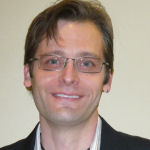
Greg Smith, PhD
This is Dr. Smith's third appearance before Scientech. Today's presentation started with a brief review of Dr. Smith's prior experience before arriving at the IMA. This was a highly technical talk profusely illustrated with slides.
Dr. Smith began by discussing lead white pigment, a substance that has been used extensively in many art forms since antiquity. This pigment blackens over time in oil paintings, watercolors, illuminations, frescoes and gilding. The conservationist's job is to reverse the blackening where it appears on paintings, etc. This is often done with admixtures of hydrogen peroxide. Blackening due to lead white use only appears on the artwork's most superficial layers.
There are multiple forms of microscopy, including HR, used in the art world. Laser Raman Microscopy is used extensively as a restoration tool today. In addition to lead white blackening/removal, the minerals used as colorants for other hues were shown by their degradation products after laser treatments. An illustration of this is the Jamnitzer Manuscript of 1585. Many colors could be restored, but of particular difficulty was the hand of a Caucasian person on the Jamnitzer which had become dark.
Lasers are also used for other purposes in art, such as in cleaning surfaces of the Parthenon. There is no physical contact between lasers and artwork, and lasers can be applied with surgical precision due to control over factors such as power, pulse width, wave length and focus. Laser set-ups can be complex or relatively simple. An interesting variation, adapted to art conservation and available today for around $50,000.00 is the Picasso Dental Laser, manufactured here in Indianapolis.
Art conservation is a highly developed blend of art and science, with perhaps the greater emphasis on science. A considerable knowledge of chemistry is required to examine objets d'art that have deteriorated over time to determining the restoration techniques to be applied to preserve these treasures for future generations. The IMA employs ten individuals, graduate scientists, art majors, and student interns in this important work.
Notes by Bob Brunner
Vol 90 No 2 - January 14, 2013
Making Indianapolis 100% Literate – Indy Reads
Presented By: Travis DiNicola, Executive Director, Indy Reads
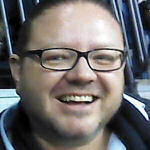
Travis DiNicola
Indy Reads is a non-profit organization that provides free tutoring programs for functionally illiterate adults in Central Indiana. It was founded in l984 as the Greater Indianapolis Literacy League. Its stated missions are to promote and improve literacy in adults in Central Indiana. It has over 800 active volunteers. The volunteers are trained and matched with adult students. They work once or twice a week one-on-one and also provide GED classes to the community. Statistically, most of their clients are reading at the second or third grade level. They also work with adults through organizations such as Goodwill and are involved in teaching at the County Jail. Through church partnerships, Indy Reads is also teaching English as a second language to immigrants.
Six years ago, Indy Reads had 360 students. It has since grown to 1400 students. It began as a partnership with other organizations such as libraries, and churches. The early organizers were librarians and the organization was part of the Marion County Library system. It became independent in 2006.
Statistically, 29% of US citizens do not read well enough to understand a newspaper story written at the 8th grade level. 20% of the adults in Indiana read at or below the 6th grade level.
Illiteracy impacts people on several levels; the most important is economic. The illiterate cannot get a job that requires skill in reading, or even fill out a job application. It has been found that children who drop out of school are usually from illiterate parents who did not read to them in childhood. Health is impacted by the lack of ability to read prescriptions, fill out health forms, or even develop proper eating habits. Emergency rooms are used instead of a Doctor's Office just because they will fill out the forms for the illiterate. It is estimated that health care cost is 4 times higher than with literate patients.
The social impact of Illiteracy is illustrated by the fact that 70% of penitentiary inmates read at a 4th grade level or less. 30% of inmates have no reading skill whatsoever. These people either become predators because of inability to find a job or become the victims of fraud and violence.
Most adult students can advance 1 reading level per year while in the Indy Read Program. 25% of their clients however are incapable of learning to read, and they try to teach them simpler skills such as following a recipe or filling out a job application. These more modest goals are implemented on a case by case basis.
A new program of Indy Reads is the Book Store. It is located at 911 Mass Avenue. They have a great number of books on sale at very reasonable prices. Children’s books are $1.00 each and other books are usually between $3 and $5. 97% of these books are donated. Other events are also held in the store such as book reading, tutor and student meetings, and there is Wi-Fi connectivity available as well.
Support of Indy Reads is mostly from private sources with little contribution from the state and other official agencies.
Notes by Gonz Chua
Vol 90 No 3 - January 21, 2013
The Return of the Peregrine Falcon to Indianapolis
Presented By: Laura James-Reim
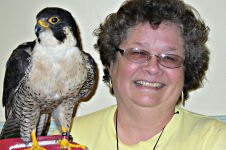
Laura James-Reim
Alison Brown, a cyber-birder, arranged our speaker today - Laura James-Reim. Laura, who lives in Greenfield, remembers hearing about the 15 peregrines released downtown in 1991 to replace the extinct local population, but did not catch the "peregrine bug", until 1996, when she could see them from her office window. From then on, these birds caught her soul and imagination. She calls that "being a Falconhead"
Our speaker now volunteers, succeeding Richard Kinnett (who joined Laura today) in monitoring the birds from the beginning of the nesting season. Mr. Kinnett began this monitoring program back in 1989. He would observe the birds on closed circuit CCTV 8 hours a day, keeping an accurate log of their activities. He informed John Castrale of the Indiana Department of Natural Resources about progress in the scrape (the nest) so the Castrale could band the eyases (chicks) about 3 weeks before fledging. Kinnett then moved outside, picking injured fledglings off the street and watched over them until their first "kill" indicating independence. Now James-Reim does the early monitoring via webcam with viewers from around the world, then joins the "Peregrine Patrol" on the streets.
Without the volunteers, like Laura, not nearly as much information would be collected about Indiana's peregrines. The Midwest population of peregrines is the best-studied of any population. Migration in peregrines, despite a name meaning "wanderer", is not as pronounced as in other species; peregrines which have their own territory do not migrate at all. The only way to tell where the banded peregrines from Indianapolis end up is to get a report of a breeding bird in another city, or the finding of an injured or deceased raptor.
The "Peregrine Patrol" monitors the activities of the young eyases as they learn how to fly from their nest on the Market Tower Building and other sites in downtown Indianapolis. Sometime a bird is rescued and returned to its nest. The mortality rate of young eyases is around 80 percent, but the rescue team hopes to improve the odds. Volunteers like James-Reim sometimes help the DNR officials in the banding of the birds, a process that includes a health check, a blood test to collect DNA for the Midwest Peregrine Register, and dusting to kill parasites.
Other interesting facts about the birds is that the male is 2/3 the size of the female - who rules the roost, and that they mate for life. Kinney, the first Indianapolis male, named for Richard Kinnett, has mated with two partners and produced 61 chicks. This falcon patriarch recently died at the ancient age of over 19 years. Along with the nest box on the Market Tower, the DNR has constructed additional boxes in downtown Indianapolis as needed. An adult bird needs to feed (kill other birds) some 2-3 times a day, and may kill up to 8 birds daily when feeding the eyases. They seem to have a hunting range of about 6 to eight miles and only take prey on the wing, stooping (diving) up to 200 miles per hour before striking the prey with balled talons.
The Indianapolis Falcons can be viewed by a live WEB cam at HERE. Other sites in Wheatfield, South Bend and Fort Wayne are available. For more about the reintroduction of the peregrine in Indiana click HERE or HERE.
Click HERE to view the Power Point slides used in this talk
Notes by Hank Wolfla, with Thanks to Alison Brown
Vol 90 No 4 - January 28, 2013
Science and Humane Care of Mentally Ill in Indiana: Pathological Department at Central State Hospital, from 1896 to Indiana University Neurosciences Center 2012
Presented By: Lucy Jane King, MD, Indiana University School of Medicine, Department of Psychiatry
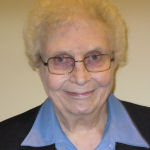
Dr. Lucy Jane King
Dr. King is a graduate of Washington University of St. Louis and is a staff member at the IU School of Medicine, Department of Psychiatry. Her talk today dealt with humane care of the mentally ill in Indianapolis from 1896 through today.
In 1896 the mentally ill received housing and treatment at Central State Hospital on the west side of Indianapolis. The superintendent at that time was Dr. George F. Edenharter who served in that capacity from 1893 through 1923. He realized that to improve care of patients he would need to increase knowledge of disorders combined with teaching to disseminate that knowledge to physicians and students. Central State was the first place in the US to combine teaching, research, and patient care in one place. Gross inspection and visible-light microscopy were their only available tools at the time, but they studied tumors, infections and brain injuries; some of their specimens remain today.
Drs. Max Bahr and Walter Breutsch were in charge from the 1920s through 1949 and made continued progress. A turning point in care of the mentally ill came in 1959 with the advent of drugs for the treatment of specific diseases such as antidepressants, mood stabilizers, antipsychotics and others.
New lab inventions such as the electron microscope and neuro-imaging sped progress. New lab techniques to study neurotransmission and the discovery of the effects of neurotransmitters such as serotonin and glycine brought greater understanding of the causes of mental disease.
La Rue Carter Hospital on W. 10th St. near the current VA Hospital came into use in the 1950s and patients with acute mental problems were treated with smaller patient loads aiding in better care. The patients with chronic disease were transferred to surrounding hospitals and many had improved enough to return home. Dr. Donald Moore served as ssuperintendent at La Rue Carter for 25 years, from 1955 to 1980, making him the longest serving superintendent of the department.
In 1986, Dr. John Nurnberger Sr succeeded Dr. Moore as superintendent of the department and director of the Institute of Psychiatric Research. He saw the need for biological research and combined people from several areas of study to investigate topics such as neurotransmitters, using genomics to study alcoholism, and acquired significant knowledge in this area.
Work continues at this time in the IU Neuroscience Health Center with the new surroundings offering an excellent facility for continued progress in the care and treatment of mental illness.
Notes by Jack Slichenmyer
Vol 90 No 5 - February 4, 2013
Automobile Propulsion Technologies
Presented By: Dan Hancock, VP, GM, Global Strategic Product Alliances, Retired
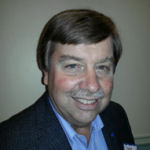
Dan Hancock
Mr. Hancock received a Bachelor of Science Degree from the General Motors Institute and a Master's Degree from the Massachusetts Institute of Technology. Among his many honors is the Medal of Honor from the Society of Automotive Engineers.
The auto industry today faces many challenges with complex future implications. Global energy demand will far outpace supply. Energy usage in 2030 is projected to increase 71% over 2003. Today petroleum supplies 96% of energy used for transportation. The supply is decreasing over time. Global, environmental and energy security factors are driving the industry to embrace energy and propulsion diversity and a desire for "green cars." Energy options include oil, biomass, natural gas, coal, renewables (solar, wind, hydro) and nuclear power. The goal is to displace petroleum over time. General Motors has improved automobile fuel economy by more than 130% since the 1970s in gasoline engines, but the potential for major future improvements is limited.
Hybridization is another way to achieve further fuel efficiency over what is possible with conventional gasoline and diesel engines. Transitioning over time from hybrid to hybrid plug-in, to all electric and ultimately to fuel cell technology is the goal. From 2002, the progression of the GM/Allison hybrid bus to the electric Chevy Volt was approximately 10 years. Even with battery improvement, the energy storage density of batteries is 100 times less than liquid fuels. GM has been making electric vehicles since 1912. The Chevrolet Volt can go 40 miles on electricity only; the engine-driven generator then produces electricity to extend its overall range up to 300 miles. The weight and volume of onboard energy storage is 10 times greater with a lithium-ion battery than with diesel fuel. Compressed hydrogen is intermediate between these two energy storage systems.
A mature fuel cell system for propulsion will result in zero emissions and zero petroleum usage with the final output being clean water.
Over time, birthrates are declining throughout most of the world and the population is aging, but the number of vehicles on the road is dramatically increasing. This will produce many challenges to the automobile industry including issues of the safety, environmental, accessibility, congestion and parking. In addition to electric and hydrogen energy needs, consideration must be given to semi-autonomous and fully automatic driving as well as tailoring the vehicle for a specific use.
At the end of the talk Mr. Hancock devoted a few minutes to discussing the decline in preparedness of our students in science, engineering and technology. He had only a few minutes to discuss the efforts of the Society of Automotive Engineers in improving this situation.
Notes by Jerry Kurlander
Vol 90 No 6 - February 11, 2013
Canada's Rocky Mountain Parks
Presented By: Lou Stanley and Bill Stanley
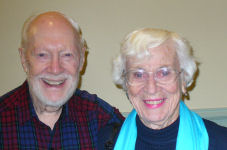
Lou and Bill Stanley
Today's excellent talk, entitled Canada's Rocky Mountain Parks, was prepared by Scientech members Lou and Bill Stanley. Lou gave the lecture.
The talk was about three contiguous National Parks in the Canadian Rockies - Banff, Jasper and Yoho. All of them have been identified as World Heritage Sites. The parks straddle the Continental Divide between the provinces of Alberta and British Columbia just north of the Montana border. These parks follow the crest
of the northern Rocky Mountain chain, formed nearly 80 million years ago, by an oceanic plate colliding with the North American plate, creating wrinkles just like a rug pushed across a hardwood floor.
Today, these Canadian parks are a major tourist destination providing a multitude of outdoor activities such as sightseeing, hiking, climbing and rappelling, skiing, river trips and viewing the flowers and animals. Banff is the gateway to the mountain parks. It is a tourist Mecca with accommodations ranging from bed and breakfasts to huge hotels and a campground with well over 1000 camp sites. Also, the town is surrounded by ski areas.
North of Banff is Johnston Canyon, site of one of the most popular hiking trails in the parks. Beyond the canyon is the massive Castle Mountain. It was renamed Mount Eisenhower after WW11 but this enraged the natives of Alberta so it was renamed Castle Mountain except for a towered-shaped peak at the end of the mountain called Eisenhower Peak.
The most celebrated area of the parks is Lake Louise. The world famous Chateau Lake Louise is at the end of the lake. From the Chateau, a 1600 foot trail leads up to a teahouse at Lake Agnes from which there is a great view of the surrounding areas. Yoho National Park is in British Columbia. At the center of the park is Emerald Lake, a popular tourist destination. Also in Yoho National Park is the world-famous Burgess Shale, a significant site of fossil preservation, featuring many animals existing during the Cambrian Explosion some 505 million years ago. Jasper National Park is located north of Lake Louise. The highlight of the park is the Athabasca Glacier, a huge stream of ice which flows down from the Columbia Icefield. One can get up and on the glacier via a special Ice Explorer bus and get off the bus and walk around on the glacial ice.
Finally, it should be noted that the talk was accompanied by spectacular photographs of mountains, lakes, waterfalls, glaciers, sunsets, hiking trails, flowers and animals. This excellent photography was done by Lou and Bill Stanley.
Click HERE to view the Power Point slides used in this talk
Notes by Herb Parks
Vol 90 No 7 - February 18, 2013
Archaeology in Your Community - Indiana's prehistoric and historical archaeological resources
Presented By: Wade T. Tharp, IDNR, Div. of Historic Preservation and Archaeology
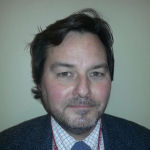
Wade Tharp
Our presenter was Wade T. Tharp, Archaeologist with the Division of Historic Preservation and Archaeology (DHPA) within the Indiana DNR. Wade has a BA in Anthropology from IU and has completed his course work for an MA in Historical Archaeology from Illinois State Univ. During his talk he addressed:
* Archaeology: myths and reality
* Archaeology today in Indiana
* How to become personally involved
* DHPA services
Myths and reality: Historical Archaeology does not include dinosaurs, but is focused on human activity. The period from 10,000 BC to 1650 AD is considered Prehistoric. From 1650 to present is classified as Historic. There are over 60,000 historic sites in Indiana and investigations continue with many more active sites. These include Native American earthworks, canals, cemeteries, and even shipwrecks. Today, archeological projects are done by private companies, government agencies like DHPA, and universities. Most field work is done in the early summer after spring semesters and before the heat of summer.
There are many ways to become involved:
* Volunteer at universities
* Visit state parks like Angel Mounds in Evansville or Mounds State Park in Anderson or the Indiana State Museum, etc.
* Attend conferences and meetings
* Donate to DHPA Trust Fund to assist homeowners who discovered historic sites and then must comply with preservation laws.
* Learn from online publications.
* Share your knowledge at Artifact Roadshows
* Join an Avocational Archaeology Group
* Participate in Indiana Archaeology Month every September
Services from DHPA include:
* Reviews project proposals and investigates new sites/finds. The staff of five reviews over 3000 projects a year including construction projects impacting historic sites.
* Administers grant funds from the Dept. of the Interior and the National Park Service for research projects.
* Maintains the Indiana State Historic Architectural and Archaeological Research Database (SHAARD)and records repository.
* Publishes educational materials including the quarterly newsletter Eavesdropping.
According to the SHAARD database, Marion County has 105 historic bridges, 145 cemeteries and 933 archaeological sites. Prehistoric sites include burial sites/mounds, villages and hunting grounds. Historic sites include cabins, settlements, rails, and roads.
The Indiana Historic Preservation Act, updated in 1989 and 2008, provides protection for archaeological sites anywhere in the state. Development plans are required for disturbing ground within100 ft. Investigations involve up to three phases. Violators who disturb, do not report or ignore plans may be subject to felony charges. Artifacts on the surface can be removed with the owner's permission, but nothing buried can be disturbed.
Click HERE to view the Power Point slides used in this talk
Notes by John Peer
Vol 90 No 8 - February 25, 2013
Lake Management in Minoqua Wisconsin
Presented By: Dick Garrett
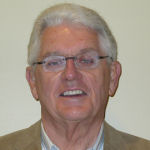
Dick Garrett
Minocqua Wisconsin is a small town located in Oneida County Wisconsin. Oneida County has 1100 lakes and Vilas County, to the immediate north, has 1300. This is a very popular area for summer residents and vacationers and as such these lakes are subject to a great deal of population "pressure". Lake management is a major issue in this part of the country. Dr. Garrett's presentation focused on three areas:
1. Storm water - reduce sediment loading
2. Reduction of phosphorus loading
3. Management of invasive species
The objective of the presentation was to give the audience an appreciation for why they see silt fences around disturbed ground, why phosphorus is so bad, why wetlands are so important, etc.
Storm water runoff.
The big enemy with respect to storm water is "velocity". Letting storm water flow freely into our lakes and streams will deliver large quantities of total suspended solids (TSS) and pollutants into the water system. This is why wetlands are so vital - they reduce velocity and thereby lower TSS and pollutants. In the case of our two lakes, Minocqua Lake and Lake Kawaguesaga, a $40,000 computer simulation run by engineering consultants showed that, in 1993, 523,000 pounds of TSS flowed into the two lakes; this number grows to 1.2 million pounds in 2025 - the equivalent of 38, 20 ton dump truck loads per year dumped into the lakes. Their simulation showed that the primary culprit in this large increase is impervious surfaces, surfaces that actually increase velocity rather that lower it. One thing that gives us hope is the fact that we can remediate the flow down to 360,000 lbs/yr. with best management practices. The computer simulation points out that the wetlands and depressions around the two lakes absorb 140,000 lbs/yr.
Phosphorus
The biggest danger a lake faces is to be loaded with too much phosphorus. Our rule of thumb is that one pound of phosphorus can promote the growth of up to 500 pounds of algae. A $330,000 United States Geological Survey explained the sources of the phosphorus flowing into the two lakes. Unfortunately, 70% of the chemical flows into our lakes from other lakes in our watershed. This makes it very difficult to correct the problem. On the other hand, the study showed that the load coming from septic systems is relatively small, so small that we do not need to lobby for sanitary sewers for the two lakes. Overall there is very little we can do to reduce the lake's phosphorus load.
One thing that is not generally known is that lake phosphorus is measured in part per billion - Minocqua Lake is currently measured to be at 16 ppb. Once the lake reaches 24 ppb, the lake goes eutrophic, the last stage of a lakes life.
There is a natural process that removes phosphorus from the water column. Here is a brief summary - phosphorus promotes the growth of algae, algae is food for zooplankton (.1 in), zooplankton is food for a variety of small aquatic fish that are food for the larger fish. Each of these living creatures
produces waste material that falls to the bottom, each dies and falls to the bottom, etc. This removes the phosphorus from the water column. In addition, 40% of the phosphorus flowing into the lake is in suspension - in time this too falls to the bottom of the lake.
Invasive species
Minocqua Lake and Lake Kawaguesaga have three known varieties of invasive species:
1. Eurasian watermilfoil
2. Curley leaf pond weed
3. Purple loosestrife
The Eurasian watermilfoil is a real curse to the lake. It reproduces by a variety of means, segmentation being the most important and will canopy, growing up to 2 inches per day, to kill all other vegetation. Since 2004 the lake association has spent over $400,000 to control this pest.
Purple loosestrife grows in the marshes and at the shoreline. This invasive is controlled with herbicides (Roundup) where accessible and by beetles bred just for this purpose.
Notes by Dick Garrett
TOUR: Rolls Royce Heritage Trust Allison Branch
Presented By: Paul Jablonski, Tour Guide
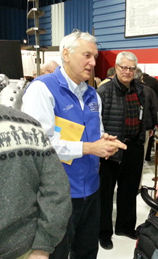
Paul Jablonski
The Rolls-Royce Heritage Trust is a non-profit volunteer organization authorized by Rolls-Royce to act as a focal point for maintaining and promoting all aspects of the engineering heritage of the company and its corporate predecessors from the earliest days to the present. The Allison Branch is responsible for the rich heritage of Allison which became a part of Rolls-Royce in 1995.
Approximately 50 members of the Scientech Club visited the Heritage Trust Museum. Mr. Paul Jablonski acted as the museum host with John Rathman and Bob Holtman serving as additional docents. The museum features engine displays of piston engines from the WW1 era to gas turbine engines of the present. Included were cruise missile engines, various sizes of helicopter engines, lift engines, military transport engines, automobile engines and the Global Hawk UAV engine. Companion information described the air or ground vehicle in which the engine was installed. Of special interest was the Supersonic Concord and vertical takeoff/landing Harrier engines, and the J35 lift fan system.
The museum is open to the public from 9:00 AM till 4:30 PM Monday through Friday with docents being available (by reservation) on Thursday.
Notes by Jim Bettner

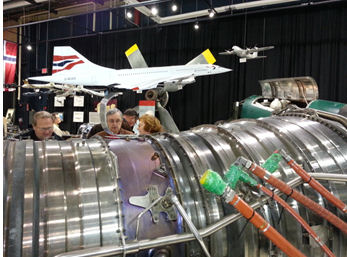
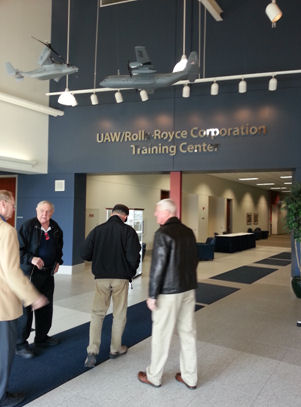
Samuel Adams, Father of the American Revolution
Presented By: Bill Dick, Scientech President
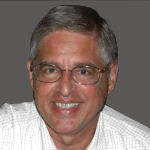
Bill Dick
As one who has read over 60 books about the Revolutionary War, its beginnings and its important actors, I must say that the book on Samuel Adams is revolutionary. He did hold several offices and even received some votes for President in 1796, but he was not one to draw attention to himself; he worked mostly behind the scenes.
George Bancroft, the noted historian, said of him in 1882, "no one had equal influence over the popular mind." His biographer, James K. Hosmer, wrote Samuel Adams in 1888, and remarked that Sam Adams ranked second only to George Washington in importance in the founding of the United States. Patrick Henry said of him after the two Continental Congresses, "the good that was to come from these Congresses was owing to the work of Samuel Adams."
John Adams, his younger (by 13 years) second cousin, asserted that "Without the character of Samuel Adams, the true history of the American Revolution can never be written. For fifty years with his pen and his tongue, he was constantly exerting himself for his country without fee or reward."
Who was this remarkable man? He was born on 16 September 1722 in Boston. He graduated from Harvard College in 1740 and earned a M.A. from Harvard in 1743. He was a partner in the family's malt house, though he was not a good businessman.
As early as 1748, he was critical of British rule. He was founder and editor of Boston's Independent Advertiser, a weekly paper of opinions about rights and liberty. He believed that Parliament had overstepped its bounds by applying the legislative acts to America. The greatest safeguards against British authority lay in the English Constitution and the Massachusetts Charter of 1691.
Adams presided over many Boston town meetings. In May 1764, it was the first political body to go on record stating that the Parliament could not constitutionally tax the colonists. Sam Adams made the first public call for the colonies to unite in opposition to Britain through a congress. In 1767, he called for a boycott against English goods. The colonists were not represented in Parliament and could not be taxed by them. Then in 1769, he hinted at independence after the occupation of Boston by British troops.
This was followed by the Boston Massacre in 1770 and the Townsend Acts. The acts were later repealed except for the tax on tea. During all this time, Sam Adams was writing articles for newspapers across the colonies. He began the Committees of Correspondence, with which the colonies communicated with each other. One of his main colleagues was Patrick Henry of Virginia.
In September 1773, Adams called for a Continental Congress. His goal was to form an American Commonwealth. He spoke to 6,000 people at the Old South Meeting House, insisting that the tea located in the Boston harbor be sent back to England. When 342 chests of tea were dumped into the Boston harbor on 16 December 1773, many suspected that Sam Adams and his Sons of Liberty were behind it.
With Sam's urging, Boston, in June 1774, formed an independent provincial congress, the first of its kind in America. The Massachusetts delegation passed a set of resolves, which Paul Revere delivered to the Continental Congress after a ride of 300 miles. This was to be one of many rides taken by Revere. The Congress unanimously endorsed the resolves. The Boston port was closed by the English and many of the colonies sent food to Boston and the surrounding towns.
Patrick Henry gave his "Give me liberty or give me death" speech in Virginia in March 1775. When the British attacked Lexington and Concord in April 1775, the American Revolution was launched. The British were looking for Sam Adams and John Hancock in order to send them to England for trial. However, the two men escaped the Redcoats. The second Continental Congress convened in May 1775. Adams served on many committees and played an important part in the negotiations.
His nearly 30 years of writing newspaper articles, pamphlets and letters to colonial leaders seemed to prepare the way for Thomas Paine's epic pamphlet Common Sense. Sam Adams served in congress and was president of the Massachusetts Senate in 1781. He was present at the Constitutional Convention in 1787 and was governor of Massachusetts from 1794-1797. His cousin, John Adams, was elected president of the U.S. in 1796; Sam Adams received the fifth most votes.
Sam Adams died on 2 October 1803. He left no papers or autobiography. John Adams collected some of Sam's papers to preserve them for posterity.
Thomas Jefferson summed it up: Sam Adams was "truly the man of the Revolution."
Click HERE to view the Power Point slides used in this talk
Notes by Bill Dick
The Long Thaw: How humans are changing the next 100,000 years of Earth's climate
Presented By: David Archer, Professor, Dept. of the Geophysical Sciences, Univ. of Chicago
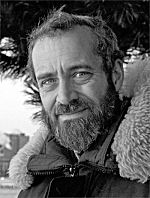
David Archer
Today was a Scientech first with the presentation being made from the University of Chicago via "Skype". Our speaker was David Archer, PhD from University of Chicago, Department of the Geophysical Sciences. Dr. Archer received his PhD degree in oceanography from the University of Washington in 1990. Since 2001 he has been a full professor of Geophysical Sciences at the University of Chicago. His talk was the review of his 2010 book "The Long Thaw" on Global Warming. He teaches an undergraduate course "Open Climate" that is a longer version of his talk and can be seen be seen at http://forecast.uchicago.edu/moodle/
The global warming forecast is not new. The basic physics of the greenhouse effect was first described in 1827 by Jean Baptiste Fourier who was a mathematician in Bonaparte's army. The "Fourier Transform" is well known to almost every area of science. Fourier's contribution is the idea that gases in the atmosphere that absorb infrared radiation could eventually warm up the earth. His analogy to a greenhouse came to be called the greenhouse effect later in history. As infrared radiation hits the molecules of CO2 it changes the vibration of the molecule that causes it to absorb heat energy. From 1800 to 2000 the concentration of CO2 has jumped from 290 ppm to 350 ppm; presently the concentration is 400 ppm. In 1896 Svante Arrhenius concluded that the doubling of CO2 would lead to about a 2.5 - 4 degrees C increase of the atmospheric temperature.
What does 420 ppm ( parts per million ) of carbon really mean? All of the models don't always agree, yet tend to project that in the entire fossil fuel era we need to be limited to 600 Gton (Giga ton) of carbon. Mankind has already released about 300 Gton of carbon as CO2 to the atmosphere. The additional 300 Gton of carbon is comparable to the remaining reserves of oil and gas.
Another issue with CO2 being placed into the atmosphere is that it takes hundreds or even thousands of years for the CO2 to dissolve in the ocean. As we place CO2 into the atmosphere over a rather short period of time, the climate change that occurs will take many thousands of years to return to a lower level. Dr. Archer calls this the "long tail model".
Dr. Archer feels that no single solution will solve the problems of our future. He feels that "wedges" of change hold much more promise. A "wedge" is a fractional solution such as using other non-coal methods to generate electricity. The burning of coal causes over 80% of the increase in CO2. Until we stop using coal for an energy resource the future of limiting the CO2 levels will be hard to achieve.
Dr. Archer's book "The Long Thaw" can be purchased from Amazon in both text and electronic editions.
"Skype" offers the club the ability to expand our network of speakers, and will be an interesting technology to explore for future presentations.
Notes by Hank Wolfla
Adventures in Beekeeping
Presented By: Mike and Debbie Seib, Indiana Beekeepers Association, Owners of Seib's Hoosier Honey
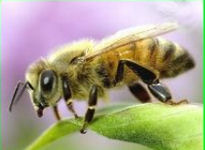
Honey Bee
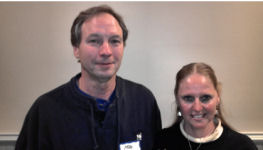
Mike & Debbie Seib
Prior to 1600 there were many species of bees in North America. There were no honey bees until they were brought to the New World after 1600. There are 20,000 bee species in the world.
Beekeepers' hives in ancient Egypt were clay pots. Skeps, baskets turned upside down, were used later but are now banned as they cannot not be inspected. The Langstroth hive has been used since 1851. Top bar hives in cities do not look like hives. There are 80 hives in metro Indy.
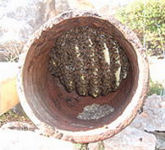
Clay Bee Hive
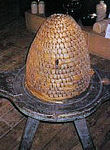
Skep Bee Hive
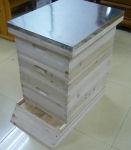
Langstroth Bee Hive
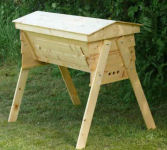
Top-Bar Bee Hive
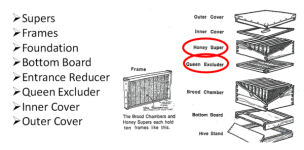
Parts of Bee Hive
There are 3 types of bees; Worker bees, the smallest; male bees or drones; and queen bees. Queen bees lay up to 2,500 eggs a day and live 2-3 years. In her lifetime she can lay over 600,000 eggs. Worker bees are female. They live only 6 weeks in late spring, summer, and fall and 4-5 months in winter taking care of the queen and keeping her warm. After birth, worker bees are house bees for 3 weeks, working in the hive. Then the worker bees are guard bees that guard the hive and finally they are field bees that get the pollen and transfer pollen to the house bees. The sole job of the male bees is to mate with the Queen. They have no stinger and are kicked out of the hive in the fall. The average bee will make only 1/12 teaspoon of honey in its lifetime.
There are medicinal uses of propolis (a resinous substance bees collect from sap flows used to seal gaps in a hive) from the bees. Experimental dentistry uses it for root canals. It is used to treat skin burns and there are pre-clinical models in Japan in treatment of tumors.
Honey has been used on burns, to treat wounded marine mammals and for antioxidant properties. It is really good to eat. One third of our total diet is dependent on insect-pollinated plants. Beeswax is also used for cosmetics, candles and to coat braces on teeth so the mouth will not be cut.
Buy your honey from a local beekeeper. Honey labeled "pure" has to be only 10% honey.
Notes by Malcolm C Mallette